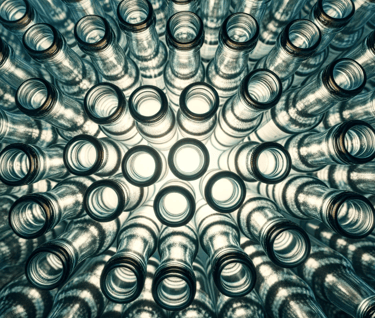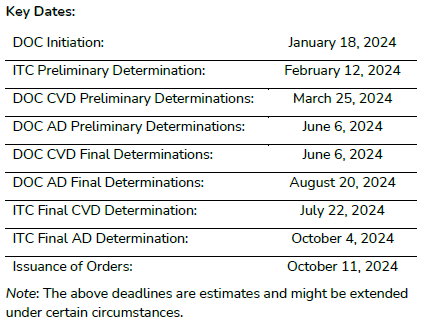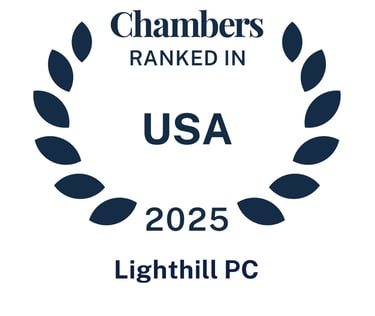Certain Wine Bottles from Chile, China, and Mexico
U.S. launches antidumping & countervailing duty investigations


On December 29, 2023, the U.S. Glass Producers Coalition, composed of the Ardagh Glass Inc. and the United Steel, Paper and Forestry, Rubber, Manufacturing, Energy, Allied Industrial and Service Workers (“Petitioner”), filed trade petitions against imports of wine bottles from Chile, China, and Mexico. The petitions seek the imposition of antidumping (“AD”) and countervailing duties (“CVD”) duties on imports from China and AD duties on imports from Chile and Mexico
The petitions were filed with the two U.S. agencies involved in antidumping and countervailing duty investigations, the U.S. International Trade Commission (ITC) and the U.S. Department of Commerce (DOC).
The value of the subject imports in 2022 was about $392.4 million, according to the Petitioner.
Case Background: In 2019, the Petitioner had filed AD and CVD petitions against imports of glass containers from China, including beer bottles, which are not part of the current action. Subsequently, in 2020, the ITC concluded there was no material injury to the U.S. industry, a determination partly attributed to the unaddressed surge in Mexican imports and a declining demand for the beer bottles under scrutiny at the time. The latest petitions aim to rectify these issues, seeking a favorable ITC decision.
The Focus of the Investigations:
The DOC will calculate the dumping margins and countervailable subsidy rates for foreign exporters of certain wine bottles from Chile, China, and Mexico.
The ITC will assess whether imports from Chile, China, and Mexico are causing material injury to the U.S. wine bottle industry.
Dumping refers to the act of a foreign company selling a product in the U.S. at a price below its normal value. This value is determined by the foreign company’s above-cost sales in its home market or a comparison market. In essence, this process evaluates price discrimination. Such analysis produces a percentage termed the "margin of dumping." The Petitioner alleges the following dumping margins for exporters of certain wine bottles:
Chile - 615.68 percent ad valorem
China - 280.10 - 620.03 percent ad valorem
Mexico - 78.55 - 102.09 percent ad valorem
Dumping refers to the act of a foreign company selling a product in the U.S. at a price below its normal value. This value is determined by the foreign company’s sales in its home market, sales in a comparison market, or even below cost. In essence, this process evaluates price discrimination. Such analysis produces a percentage termed the "margin of dumping." The Petitioner alleges the following dumping margins for exporters of certain wine bottles:
Countervailable subsidies are financial assistance from foreign governments that benefit the production, manufacture, or exportation of goods and are specific to the exporter, industry, or geographic region (countervailable subsidies). These subsidies may be in the form of discounted loans, tax breaks, direct grants, or low-cost rent, etcetera. Petitioner alleges numerous countervailable subsidy programs for producers and exporters of wine bottles:
China – thirty-eight programs
There is some historical reference for the duties those subsidy programs might translate into. In 2020, the DOC calculated CVD rates in the twenties for the cooperating companies and three hundred percent for the non-cooperating ones. But as mentioned above, no AD and CVD orders were published because of the ITC’s no injury determination.
Mandatory Respondents
For countries with a vast number of producers and exporters of certain wine bottles, the DOC is expected to examine only two companies. Typically, these companies are chosen based on their export volume to the U.S. They will be mandated to actively participate in the investigations. Moreover, the dumping margins and countervailable subsidy rates determined for those companies will likely set the duty rates for other producers and exporters.
Injury investigation initiation notices are usually published shortly after the petitions are filed. The ITC will have 45 days to reach a preliminary determination. Producers, importers, and exporters can participate in this investigation by responding to questionnaires about the production, importation, and sales of certain wine bottles. These questionnaires will be issued soon. All mentioned parties can also defend themselves at the ITC against claims that imports are harming the U.S. industry.
Retroactive duties may be required for merchandise currently in transit or expected to be shipped soon. The additional duties normally become effective when the DOC makes the affirmative preliminary determinations. However, if Petitioner alleges critical circumstances and dumping or subsidization is determined, imports arriving post-December 29, 2023 (petition filing date) but prior to the AD and CVD preliminary determination dates could face retroactive cash deposits.
REQUESTED SCOPE OF MERCHANDISE UNDER CONSIDERATION
The merchandise covered by the investigations is certain narrow neck glass bottles, with a nominal capacity of 750 milliliters (25.36 ounces), consistent with the authorized standards of fill in 27 C.F.R. § 4.72; a nominal total height between 24.8 centimeters (9.75 inches) to 35.6 centimeters (14 inches); a nominal base diameter between 4.6 centimeters (1.8 inches) to 11.4 centimeters (4.5 inches); and a mouth with an outer diameter of between 25 millimeters (.98 inches) to 37.9 millimeters (1.5 inches); frequently referred to as a “wine bottle.” In scope merchandise may include but is not limited to the following shapes: Bordeaux (also known as “Claret”), Burgundy, Champagne, or Sparkling. In scope glass bottles generally have an approximately round base and have shapes including but not limited to, straight-sided, a tapered slope from shoulder (i.e., the sloping part of the bottle between the neck and the body) to base, or a long neck with sloping shoulders to a wider base. The scope includes glass bottles, whether clear or colored, with or without a punt (i.e., an indentation on the underside of the bottle), and with or without design or functional enhancements (including, but not limited to, embossing, labeling, or etching). In scope merchandise may be imported with or without a closure, including a cork, stelvin (screw cap), crown cap, or wire cage and cork closure.
Excluded from the scope of the investigations are: (1) Glass containers made of borosilicate glass, meeting United States Pharmacopeia requirements for Type 1 pharmaceutical containers; (2) Glass containers produced by the “free blown” method or otherwise without the use of a mold (i.e., without “mold seams,” “joint marks,” or “parting lines”); and (3) Glass containers without a “finish” (i.e., the section of a container at the opening including the lip and ring or collar, threaded or otherwise compatible with a type of closure, including but not limited to a cork, stelvin (screw cap), crown cap, or wire cage and cork closure).
Glass bottles subject to the investigations are specified within the Harmonized Tariff Schedule of the United States (HTSUS) under subheading 7010.90.5019. The HTSUS subheadings are provided for convenience and customs purposes only. The written description of the scope of the investigations is dispositive.






